- Images
- Blog
- Tools
- Questar
- The Questar telescope
- Questar resource links
- Search for Questar info
- 172mm Focal Reducer
- Afocal adapter for point and shoot camera
- Camera adapter lengths
- Camera adapter threading
- Camera connection
- Camera focusing
- Custom counterweight
- Drift Alignment Joy
- Finder Eyepiece Compatibility
- The Questar Moon 1981
- Questar Powerguide II Battery Life
- Questar Zone, How to Service Videos
- Red Dot finder mount for Questar
- Questar Viewing Table
- Wedge mounts
- White light solar filters comparison
- How to
- Get started in astronomy
- Astro RaspberryPi Camera and kin, the ASIAir and StellarMate
- Blind Smart-phone Equatorial Wedge or GEM Polar Alignment
- Camera phone adapter
- Celestron FirstScope with equatorial tripod mount
- Coat Pocket Astrophotography
- Day-lapse Images of Earthshine on the Crescent Moon
- Dobsonian Carrying Case
- DSO Astrophotography without a Telescope
- DSO imaging without a star tracker
- Estimating image resolution
- Lunar Eclipse Photography
- Moon photography - a dozen ways to shoot the Moon
- Meteor shower photography & planning
- Matching image sensor size to telescope resolution
- Narrow band imaging with color cameras
- Planetary Image Workflow
- Print and Display Astrophotography
- Observing
- Events
- More
- About
- Contact
Choose & setup a camera for astrophotography
Suitable cameras for astrophotography include both conventional cameras with interchangeable lenses (ILC) and dedicated astrophotography video cameras. Astronomical video cameras require a separate computer and display to focus, frame the image, and save images, as well as a telescope. In return they have good near IR sensitivity for emission nebulae and cooled sensors which reduce noise and simplify image calibration.
Many people already own a conventional ILC DSLR or mirrorless camera for daylight photography. I recommend them for astrophotography, because of their familiarity, simplicity, and flexibility. They are self contained, easy to use, and can deliver outstanding results with and without a telescope for many different kinds of astrophotographs. Some can be modified for better near IR sensitivity to capture emission nebulae.

Start with a camera you already own
If you already have a camera with a removable lens, all you need is a sturdy tripod to make your first astrophotographs. With sturdy tripod and a lens of 50 mm focal length or less you can make Make Milky Way or star trail images. With a longer telephoto lens, you can take sharp, clear, images of the moon. Telephoto shots of dimmer deep sky objects will require a star tracking mount. Once you are taking images, you will begin to appreciate the value of the features listed here. If you are frustrated by the lack of some of them or don’t already have a camera, use these as a guide to picking a new camera well suited to astrophotography.
Choose DSLR or Mirrorless
There are two common types of ILCs: DSLRs and mirrorless cameras. Both can work well but mirrorless cameras have advantages for astrophotography:
- Mirrorless cameras are light and compact. The single lens reflex mechanism adds weight, size, and vibration to a DSLR without adding any advantages for astrophotography. The vibration of the SLR mirror can be minimized by a mirror lock up feature, but the added weight of a DSLR reduces balance and stability. A heavier camera also requires a heavier and more expensive tracking mount.
- Mirrorless cameras have a short flange to sensor distance. This reduces the back focus distance required, making them easier to use with reflecting telescopes with limited back focus distance.
- Mirrorless cameras tend to have good on screen focusing aids.
- The short flange to sensor distance also allows almost any manual lens to be adapted to a mirrorless camera with an inexpensive mechanical adapter. High quality vintage manual lenses designed for SLR cameras are very inexpensive. You can easily save the cost of a new mirrorless camera body by buying second hand vintage lenses.
These are good reasons to choose a mirrorless camera body over a DSLR if you are purchasing a camera specifically for astrophotography. If you already own a DSLR you can probably get good results with it. If you also use your camera for wildlife or sports action shots you may want to choose a DSLR and work with its limitations for astrophotography.
Full frame or crop sensor
Sensor size and sensitivity are the most important features of your camera for astrophotography. Look for:
- Good low light sensitivity - Most camera photos are taken in daylight and cameras do not perfume equally well in low light. You can get sensitivity and dynamic range information for camera testing sites like DPReview or DXOmark. Sony and Nikon’s best cameras have been leaders in low light performance. A couple of stops difference in dynamic range between the best and worst low light cameras isn’t unusual. What difference does two stops make? Your images will either have four times as much noise in them or you will need to take many more exposures to reduce noise by stacking more images.
- A large sensor - Most telescopes give a “circle of light” that can expose all of a full frame (35mm film size about 36 mm x 24mm sensor). Smaller sensors will leave out part of the image and require additional exposures to cover the same area with a mosaic of multiple images. APS sized crop sensor (about 24mm x 16mm) captures less of the image, but lenses of the same focal lengths are usually smaller and lighter than full frame equivalents. APS sized cameras and lenses are significantly less expensive than full frame versions. Noise increases as sensor size decreases. Most astrophotographers use either full frame or APS size sensors. You can take astrophotographs with Micro 4/3 and 1” sensor cameras, but the images are noisier or take longer or more exposures.
Which camera lens or telescope
ILC cameras can be mounted on a telescope with an adapter usually called a T-ring. The T-ring will connect to your camera's bayonet adapter in place of a camera lens. The other end of the T-ring has an M42x0.75 mm threaded connection. If your telescope doesn't have a matching thread there are adapters to other threads and also slip-fit adapters that will mount the adapter in place of an eyepiece (1.25 or 2 inch). The telescope then functions in place of a telephoto lens on your camera.
Be aware that using a telescope or telephoto lens for astrophotography, for anything other than the Moon or Jupiter, requires a motor driven star tracking mount. Newtonian reflecting telescopes often don't have sufficient back focus adjustment distance to come to focus with a camera without additional lenses or modifications, this is especially true of DSLRs. If your telescope is a refractor or catadioptric scope, with the eyepiece at the bottom (back) of the telescope, there is a good chance that it will work with most cameras with the right adapter.
Almost always the best lens to start with for astrophotogaphy is a fast wide angle short focal length prime lens. You can get by with only a sturdy tripod without an expensive tracking mount. If your only lens is the kit zoom that came with your camera, go ahead and give it a try.
Don't be tempted to buy a super zoom camera with a built in zoom lens for astrophotography. If you already have one, give it a go. If you purchase a camera for astrophotography, an ILC gives you the flexibility of using higher quality prime lenses and telescopes. This flexibility often costs less than an all in one super zoom camera.
If you will be using a fixed tripod to start, the earth's rotation will limit your targets and the focal lengths usable by your camera. The most useful lens for astrophotogaphy from a fixed tripod is a short focal length (< 20mm) prime lens. If you only have a zoom start with it zoomed all the way out to its shortest focal length. This will let you shoot the Milky Way, star trails, meteor showers, and dramatic nightscape images.
A long focal length lens (> 135mm) can show the
moon in clear detail, but the long exposures required by dimmer targets
require a star tracking mount. A good rule of thumb for the longest
exposure that won't show obvious star trails is the Rule of 500. Divide
500 by the full frame equivalent focal length of your lens for the
maximum exposure time in seconds.
Prime lenses give
better results than zoom lenses of the same quality.
The more glass that starlight goes
through, the dimmer and more distorted it becomes. Zoom lenses are
convenient for daylight photography, but may contain more than a dozen
internal lenses. If you
already have a zoom, start by using it. When you notice that stars near
the edge of your image look like little comets or rainbows, it's time to
look for a good apochromatic/ED prime lens or even better a telescope designed for
astrophotography.
If you have a mirrorless ILC, vintage SLR prime lenses can let you reach for deep space at a tiny fraction of the cost of a new lens or telescope.
Look for these features
For any camera there are features that will make it easier to get good astrophotography results. If your camera doesn’t have some, you can work around them. If you are buying a camera specifically for astrophotography, you should look for these and understand their value to you.
- Remote shutter release- these can be mechanical, infrared optical, electrical cables, or wireless. Using your cameras shutter button will shake the camera and blur the image. An exposure delay can be used as an emergency substitute.
- Manual settings- Automatic features for focus, exposure, white balance, and image stabilization do not work well in low light. Manual exposure is required for astro photography. Stacking images to increase sensitivity and reduce noise requires consistent manual exposure and white balance. If your camera has any of these automatic features for daylight images, you need to be able to turn them off for astrophotography.
- Raw image format- the common JPEG format only captures 8 bits of your camera’s 12 to 14 bit dynamic range. A raw format with lossy compression or built in noise reduction can be problematic. It’s easy to mistake a dim star for a bit of noise. It’s much better to have unmodified raw sensor data and handle noise and exposure issues in image processing software
- Long time exposure settings- fixed time exposures to at least 30 seconds and manual bulb exposures are needed to gather enough light.
- Mirror lock up feature- a DSLR needs this for sharp long exposure images. A mirrorless camera has no mirror to lock up.
- Electronic first curtain shutter- eliminates vibration due to a mechanical shutter.
- Silent or fully electronic shutter- eliminates shutter vibration, but may increase noise.
- A tilting or articulated view screen- A camera points up for astrophotography. If your camera screen can’t tilt to face the front (think selfie), you will spend a lot of time down in the dirt.
- Electronic focus aids- perfect focus is critical for astrophotography. The infinity mark on a manual lens isn’t good enough. A magnified real time image on a bright screen greatly speeds low light focusing. Electronic focus peaking paints focused points and edges in a bright color for fast precise focusing.
- Real time low light finder view- Some cameras (Sony) offer a view screen mode which can show the Milky Way in real time using a rolling stack. This makes framing your shot fast and sure in very dark conditions. Taking long exposure test shots is much slower.
- Intervalometer or shot timer- most astrophotography requires multiple images that will be combined in post processing. You can use an external intervalometer in a camera with a remote shutter release. An internal intervalometer is more convenient and won't be left behind, but may be less flexible than an external unit. With this you can relax and enjoy the sky while the intervalometer handles taking images.
- External power connector or dual battery support- astrophotography can require hours of images for stacking or a time lapse. This can be beyond the capacity of an internal camera battery especially in cold weather. Both my Sony cameras and my star tracker accept power from small USB connectors and can be powered from a small lithium ion batter pack. Some cameras will only charge the internal battery from the USB connector which isn't useful when operating the camera. With one that operates under USB power you will never have to worry about batteries running down in a long imaging session. Dual internal batteries and external battery power grips serve the same purpose.
- Long exposure noise reduction control- many cameras now offer built in long exposure noise reduction. This works by taking an additional exposure with the shutter closed and subtracting it from the image. This means that your camera is only gathering star light half the time. It is much more efficient to shoot a few dark frames with a cover over the lens. Then shoot lots of light frames and subtract the dark frames out in post production software. Make sure that you can turn this feature off.
- Infrared sensitivity- consumer cameras have a fixed internal filter that cuts out most near infrared light. Unfortunately this includes the Hydrogen alpha emissions that give emission nebulas their wonderful red color. A few camera makers (Nikon, Canon) make special models for astrophotography with better IR sensitivity. Other cameras can have their in-camera filters replaced by 3rd parties for better IR sensitivity.
- Video- UHD 4k or 100% center cropped lower resolution videos are useful for high resolution planetary images.
- Tethered shooting- Tethering to a remote computer allows you to compose and focus your images on a large screen. Computer software can automatically focus your telescope with a motorized focuser. Orchestration programs can execute pre-planned sequences of images for events like eclipses. Canon has been a leader with cameras that are widely supported by tethered remote software. Support for Nikon and Sony cameras is becoming more common.
- Good controls- Saved configurations, customizable buttons, dials, and menus can make a camera much easier to operate in the dark.
For an idea of the variety of ways that you can use a ILC camera in astrophotography see the images below. These were taken with both crop sensor and full frame mirrorless cameras. Some were on a fixed tripod and others required tracking mounts. Camera lenses from 14mm f/2.8 to 300mm f/5.6 and a 1350/89 mm f/15 telescope were used.
The image below was taken with a crop sensor Sony a6300 with a 135mm lens on a fixed tripod:
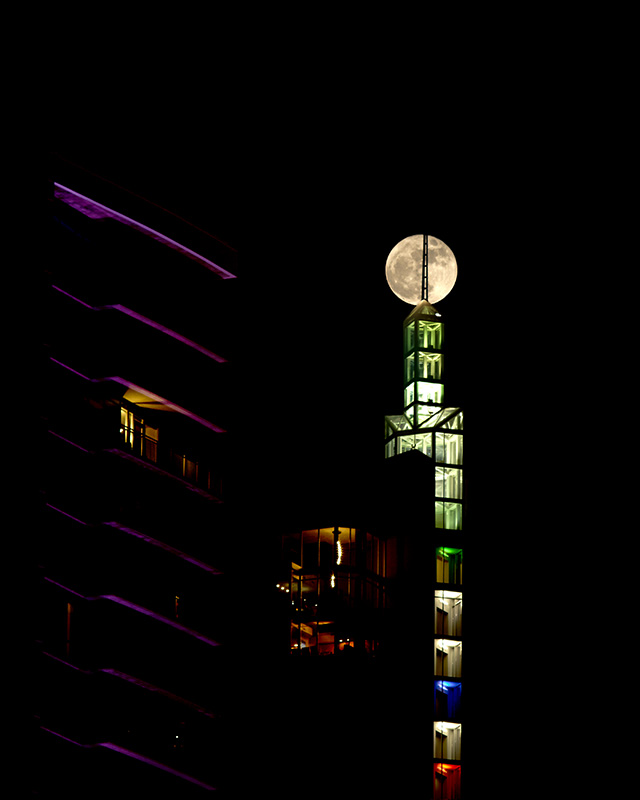
The Milk Way can be shot with a wide lens from a fixed tripod. Here with a full frame Sony a7iii and a Samyang 14mm lens:
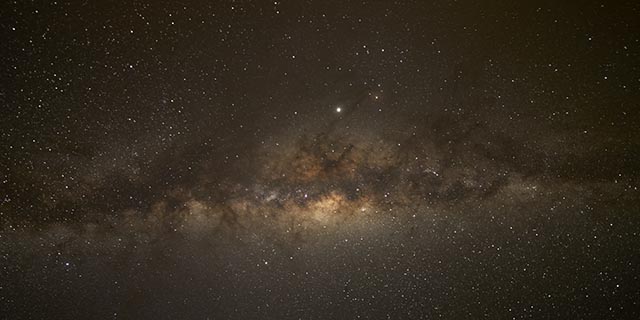
A star tracking mount with a simple ball head for deep space images:
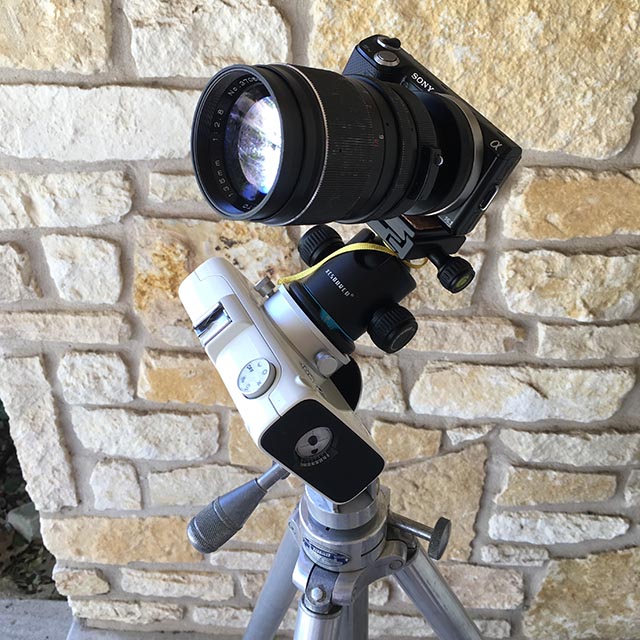
Image below taken with a Sony NEX-5N 16MP crop sensor camera and a 135mm vintage lens with the setup shown above.
The sword of Orion taken with a Sony a7iii, a Nikkor 300mm ED lens, and a Vixen Polaie star tracking mount:

A star tracking mount with a small telescope using a panoramic head, declination L-bracket mount, and counterweight:
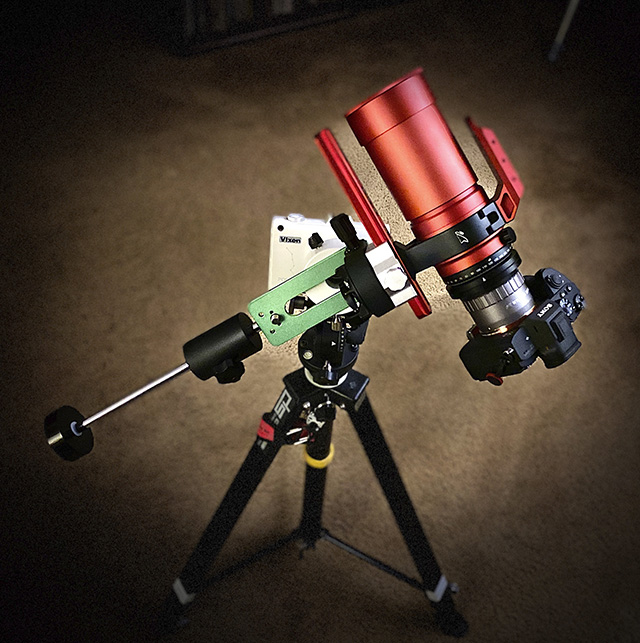
The sword of Orion taken with a Sonya7iii, Redcat 250/51mm f/4.9 telescope, and the Vixen mount with a counterweight:
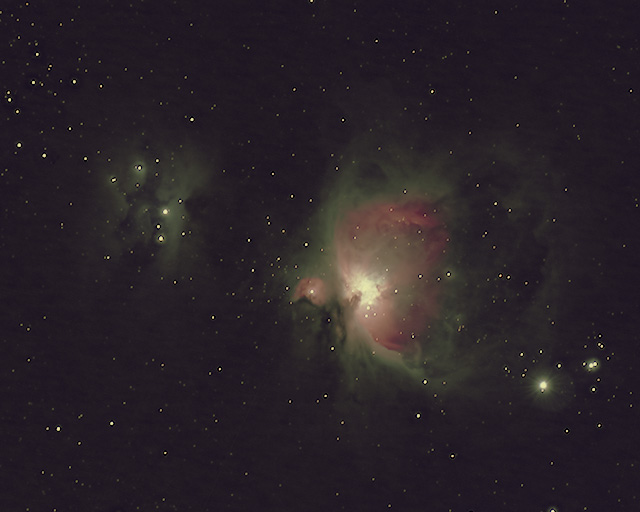
A fork mounted telescope with built in tracking drive for lunar close ups
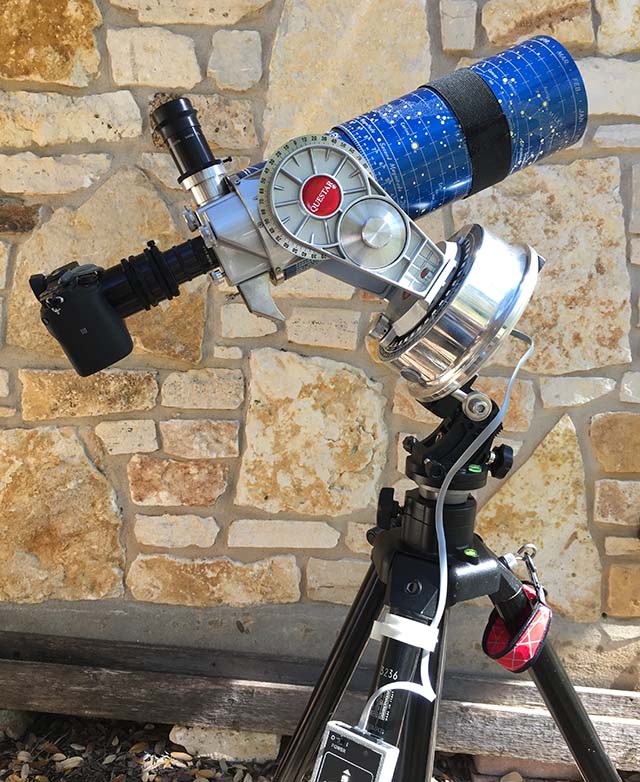
Images below take with a Sony NEX-5N 16MP crop sensor camera and Questar 89mm telescope
Planetary images using lucky image stacking benefit from the fast video frame rates of astronomical video cameras, but good results are possible with an ILC camera like the Sony a6300 and a small telescope like the Questar 89mm
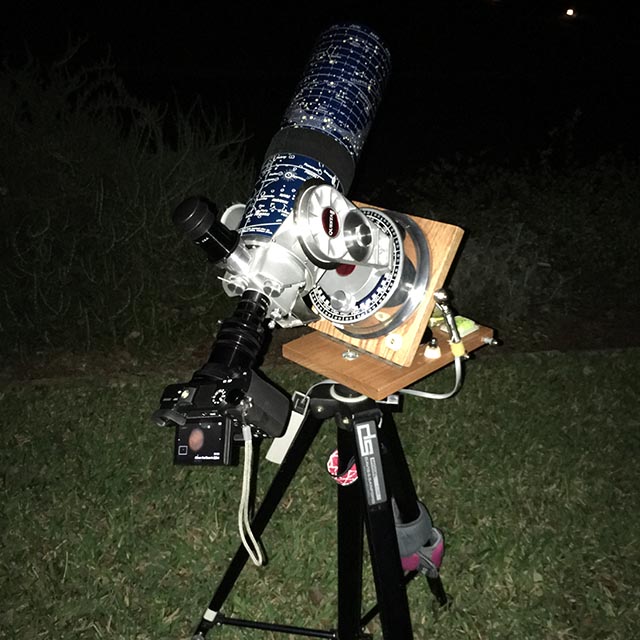
Image below take with a Sony NEX-5N 16MP crop sensor camera and Questar 89mm telescope
Content created: 2019-11-26 and last modified: 2020-12-09
Comments
![]() Submit comments or questions about this page.
Submit comments or questions about this page.
By submitting a comment, you agree that: it may be included here in whole or part, attributed to you, and its content is subject to the site wide Creative Commons licensing.

How to
Starter telescopes for beginners
Getting started in astrophotography?
Choose & setup a camera for astrophotography
Astro RaspberryPi Camera and kin, the ASIAir and StellarMate
Blind Smart-phone Equatorial Wedge or GEM Polar Alignment
Celestron FirstScope with equatorial tripod mount
Day-lapse Images of Earthshine on the Crescent Moon
DSO Astrophotography without a Telescope
DSO imaging without a star tracker
Overview & equipment for lunar eclipse photography
Framing and tracking a lunar eclipse
Moon photography - a dozen ways to shoot the Moon
Meteor shower photography & planning
Matching image sensor size to telescope resolution
Narrow band imaging with color cameras
Print and Display Astrophotography
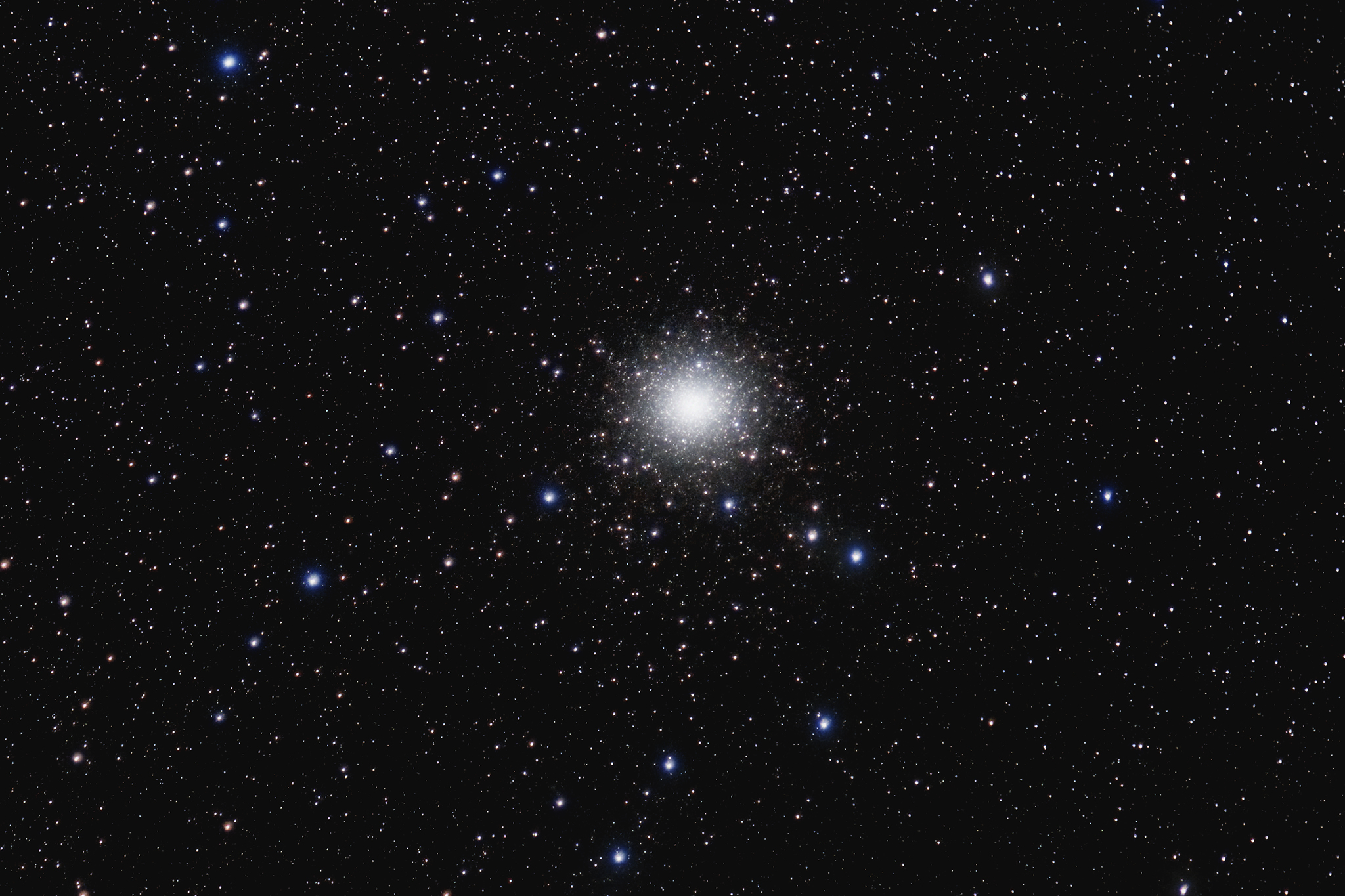

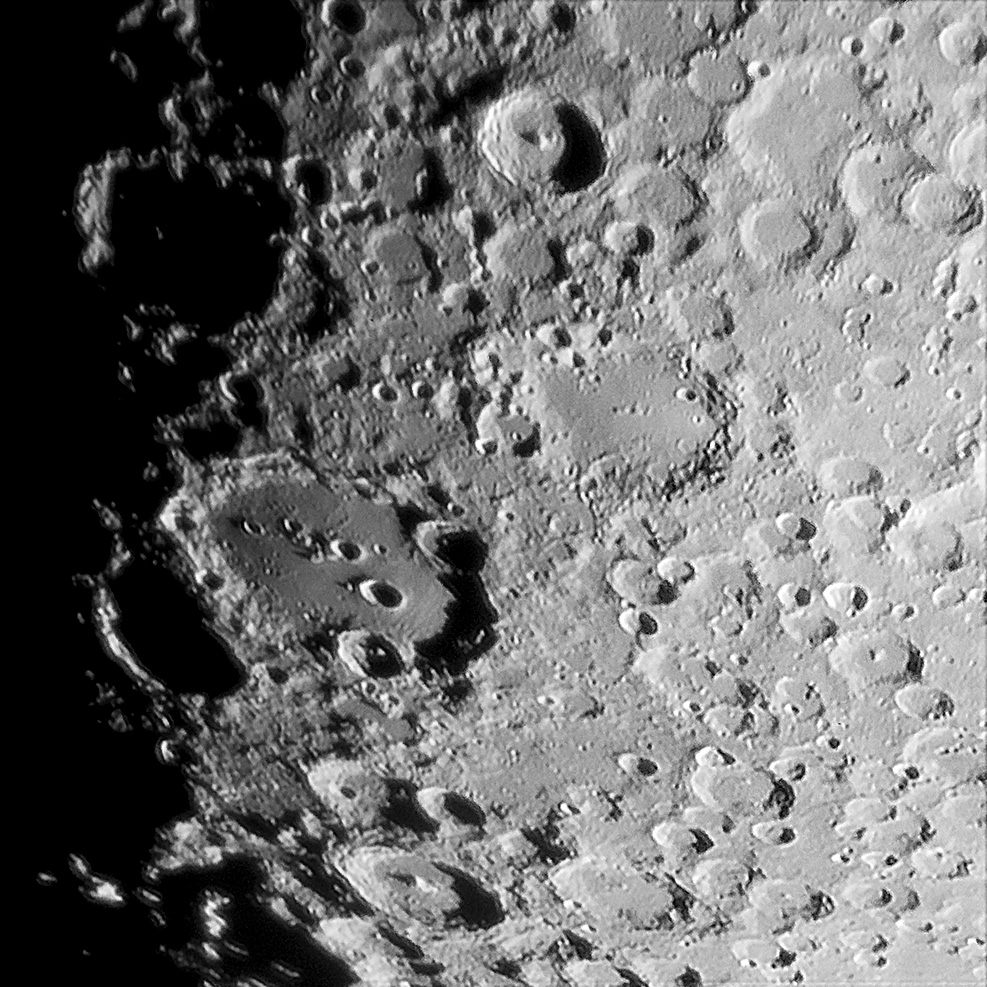



 Lunar Eclipse Photography
Lunar Eclipse Photography